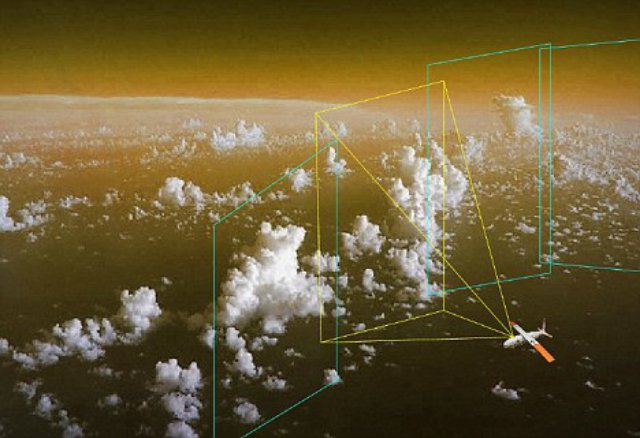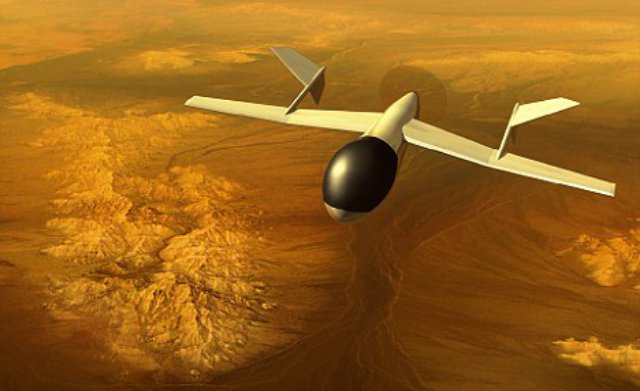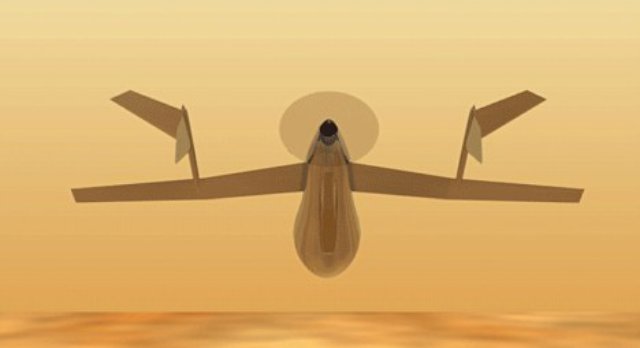Dr. Jason W. Barnes of the University of Idaho and a team of 30 scientists and engineers created an unmanned mission concept to explore Titan called AVIATR (Aerial Vehicle for In-situ and Airborne Titan Reconnaissance). The plan, which primarily consists of a 120 kg unmanned aircraft soaring through the natural satellite’s atmosphere, was published online late last month.
“As far as its scientific interest, Titan is the most interesting target in the Solar System,” said Barnes. Titan – Saturn’s largest moon – is it’s the only other body in our solar system (besides Earth) that has that type of atmosphere and evidence of liquid on its surface. It has been said that the atmosphere on Titan is so dense that a person could strap a pair of wings on their back and soar through its skies.
The goal of the plane concept – which according to Barnes can serve as a standalone mission or as part of a larger Titan-focused exploration programme – is to study the moon’s geography (its mountains, dunes, lakes and seas), as well as its atmosphere (the wind, haze, clouds and rain – Titan is the only other place is our solar system where it rains).

The probe would be equipped with a horizon imaging camera - and would roll in flight to capture full images of cloud banks floating above the planet
AVIATR is composed of three vehicles: one for space travel, one for entry and descent into Titan, and a plane to fly through the atmosphere. AVIATR, estimated to cost $715 million, would not prevent other missions from occurring on Titan, Barnes said. Instead, it would supplement the science being done by other projects.
“The science that AVIATR could do complements the science that can be accomplished from both orbiting and landed platforms,” the article stated. Unfortunately, it seems like the plane concept won’t be happening anytime soon. That’s because Titan didn’t make the National Research Council’s “Decadal Survey” – a prioritization of future planetary missions. “Titan was deferred to another decade,” Barnes said.
But, he hopes to continue to build support for AVIATR so that it can get onto the next decadal survey in 2020. “We certainly had a lot of interest from people. We are breaking the paradigm that a balloon was the right way to go to Titan,” Barnes said.
So, why send an unmanned plane to study Titan’s atmosphere?
“Titan is the best place to fly an airplane in the whole solar system. We can go when and where we want,” Barnes said, adding that when compared to Earth, there’s four times more air and seven times less gravity on Titan. “A balloon is stuck in the wind. A balloon entrained in primarily zonal winds near the equator would have no mechanism by which to travel to the polar regions to observe lakes and shoreline processes. Even if it were possible to get there, it is not clear that it would be desirable to send a balloon to the poles where Titan’s most violent meteorological activity takes place. AVIATR is both able to fly to the poles and is sufficiently robust to survive there.”
“The radioactive decay of plutonium-238 provides the heat that powers RTGs, which can power spacecraft where there is insufficient sunlight for solar panels to operate. NASA is presently investing in a new type of RTG, called the ASRG,” the article stated. “A traditional hot-air balloon will not work on Titan with an ASRG owing to its lower heat production. In contrast, the AVIATR mission is specifically enabled by the use of ASRGs. The power density (in Watts per kilogram) and longevity of the ASRG allow an electrically-powered aircraft to fly on Titan.”
A plane could also find potential landing spots for future exploration. And, “since we are flying, we fly west the whole time so we can stay on the day side of Titan,” Barnes said. That daylight would also help AVIATR collect photographic data during its travels and, according to Barnes, when it’s time to downlink that information, the plane would conserve energy by gliding through the air. “And in doing so, we can also sample of bunch of altitude ranges,” Barnes said. “We are sampling the whole time.”
The plan seems interesting enough, but it’ll be quite a while before any data from the prospective mission would be coming back to Earth. If the plan is accepted (the earliest being 2020), the project would still have to be built, then once completed it would take 7 1/2 years to reach Titan. Once there, the mission would take about a nominal Earth year to study.
“I now realize that it’s a career-long project,” Barnes said to Universe Today. “The plan at this point is to keep this in the forefront of people’s minds and take whatever new ideas that people suggest and try to improve its prospect for selection.
To view the complete proposal, published in Experimental Astronomy, go here.
Sources: Universe Today, The Daily Mail


